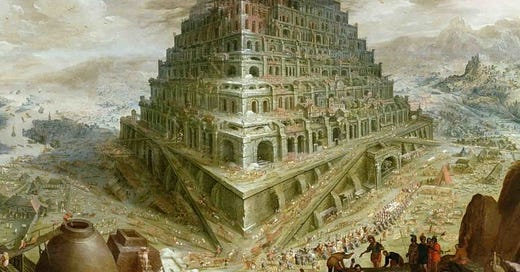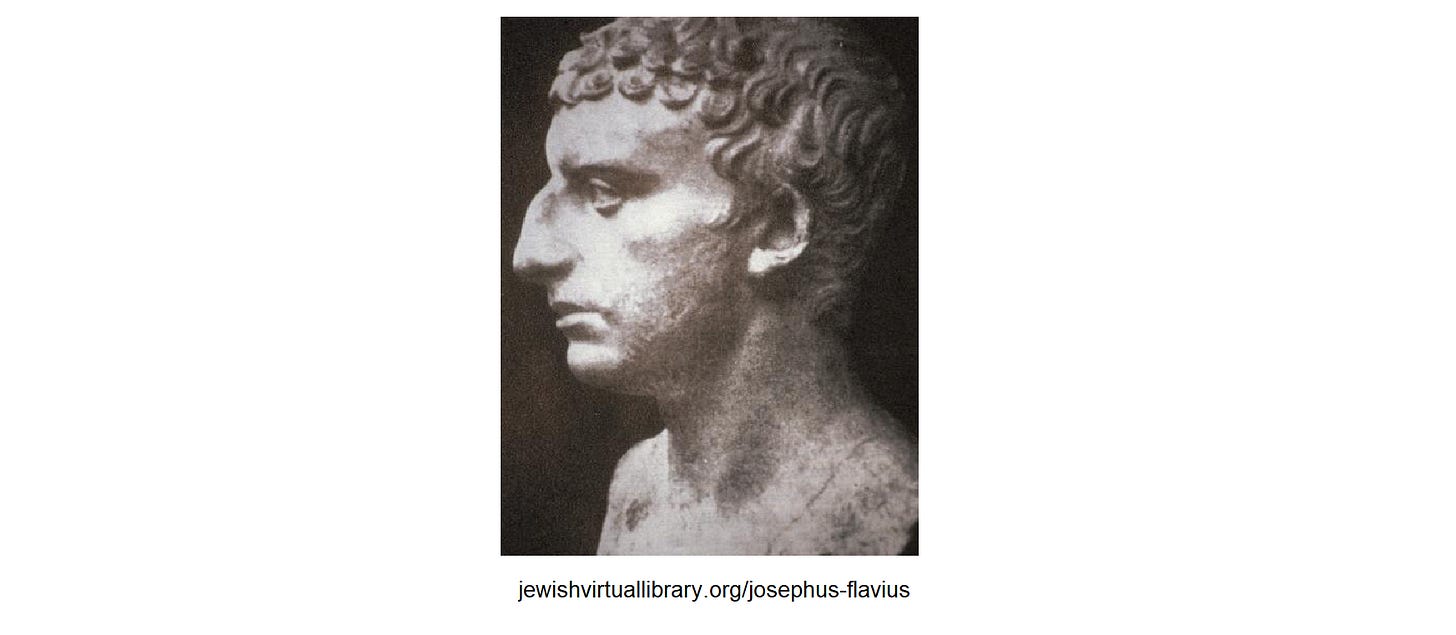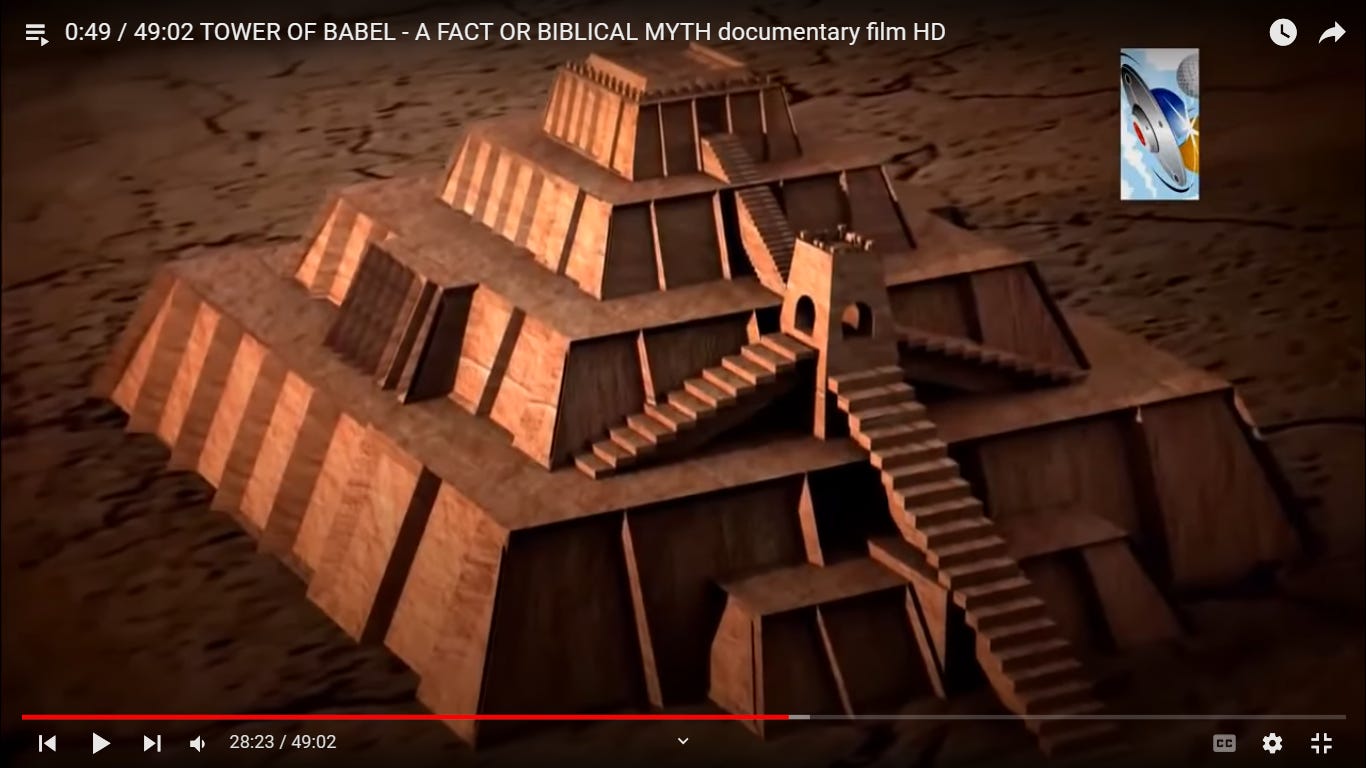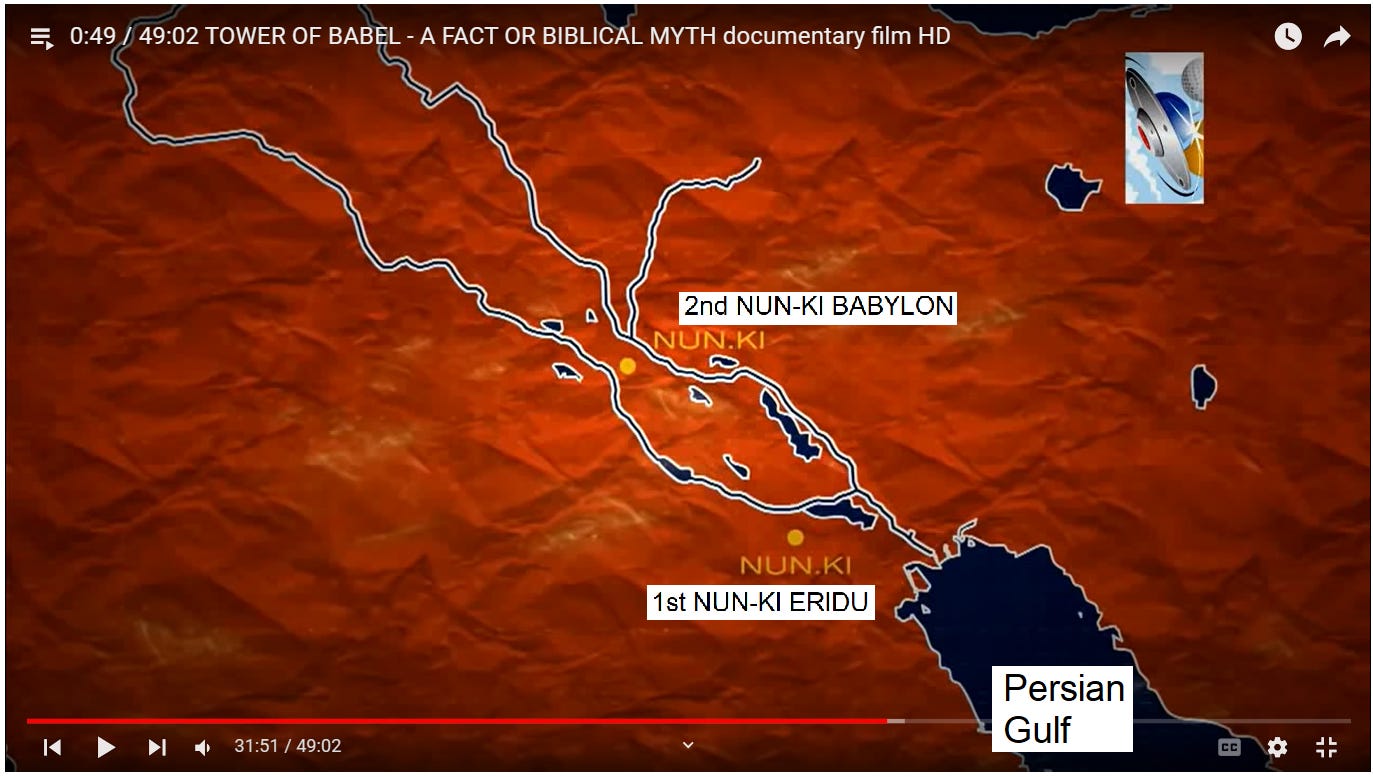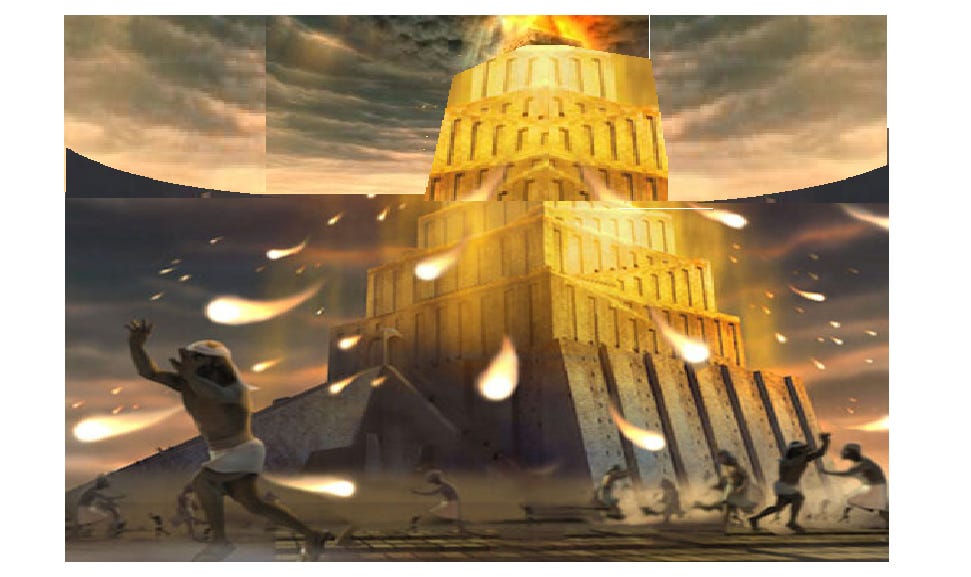This is my tentative Cataclysmic Timeline.
Great Flood at 3,300 BC; Ice Age to Younger Dryas Event at 2,600 BC; Sahara Flood at 2,300 BC; Dead Sea Disaster at 1,800 BC; Exodus at 1,447 BC; Trojan War at 860 BC; Diaspora at 70 AD.
The Tower of Babel dispersion seems likely to have occurred c. 2,300 BC, related to the Sahara Flood, caused by the Burckle Crater Impact and others. David Rohl and Ron Wyatt (who probably never met each other) have apparently found separately a lot of evidence of important people, places and things from events described in the Bible. The Tower of Babel was likely found by Rohl.
Following are excerpts from this video: TOWER OF BABEL - A FACT OR BIBLICAL MYTH? documentary film HD
BIBLE STORY
... The legendary Tower of Babel in the Bible was the first great city on earth. {But it may have been square instead of round.}
Tower of Babel (Part 5) Archaeological Evidence - Truth Watchers
... The convention is that the {Genesis stories} happened in the 3rd and 4th Millennia BC, between 2000 and 4000 BC. Elsewhere in the known world, it's the dawn of ancient Egypt, but it's also the cradle of the very first city-civilization on Earth, ancient Mesopotamia. This land will be home to Sumerian, Assyrian, and Babylonian Empires. If the Tower of Babel is anywhere, it will be somewhere in this fertile land. Rohl has a rough idea of the area and time in which to search for the Tower of Babel. But to home in on the precise spot and time, the chapter on the Tower of Babel has nothing useful. So Rohl looks for clues in the chapter before, known as the Table of Nations. It lists the descendants of Noah's three sons. The Bible says that humankind descended from these three and each nation's ancestor is said to be linked to them. So the story just says that these people are born. We don't get any details. And in this chapter Rohl is amazed to find a mention of Babel. The creation of the city is credited to an individual ... called Nimrod. As a descendant of Noah, it's likely he would have lived sometime in the third Millennium BC. We come across an important character in the book of Genesis. This is King Nimrod. Nimrod comes a generation or so after the Flood. Now he is not associated in the Bible with the Tower of Babel. What it says is that Nimrod was a mighty hunter before the Lord. Nimrod is called in the Bible the first ... prototype on earth, {which} basically means he was a great king. Rohl is intrigued. Nimrod is credited with the Foundation of Babel, but not with the building of the tower.
... But the Bible offers little more. Nimrod was the son of Kush, and he's described as a great hunter and a mighty hero.
JOSEPHUS
... Around 94 AD, a Jewish historian writes Antiquities of the Jews, ... Josephus….
... Rohl finds that Josephus relies on other ancient sources to compile his history. Like the Bible, Josephus does not say where Babel was, but it does connect Nimrod directly to the building of Babel's tower. Josephus does say that Nimrod was the king who built the Tower of Babel, so we have this connection between Nimrod and Babel. And what Josephus tells us as he built the Tower of Babel as a sort of refuge in case God sent another flood to destroy mankind. So the people could go to the top of the tower and be saved from the flood. At last, Rohl has a connection between a character in the Bible and the Tower of Babel. Maybe Nimrod really did build the Tower of Babel? But only if he was a real flesh and blood king of Mesopotamia.
SUMERIAN KING LIST
... {At Oxford’s} Ashmolean Museum inside a Department of Antiquities that houses many treasures from ancient history, including many from the southern region of Mesopotamia called Sumeria, Rohl zeroes in on a clay prism about 20 centimeters high, dated to around 1800 BC, each side transcribed in cuneiform script, the ancient text of Mesopotamia. It is called the Sumerian King List, a rollcall of every king who ruled Sumeria, the first civilization of ancient Mesopotamia.
... Rohl examines the King list carefully. He finds no mention of King Nimrod, but he does discover the name of another king who, like Nimrod, ruled in the third Millennium BC. We do have one extremely interesting character. He comes one generation after the flood in the Sumerian tradition. It's called Enmerkar. The King list says that Enmerkar ruled from around 2700 BC for hundreds of years. And it says he founded a city called Uruk, not Babel. Rohl then discovers there are more ancient texts detailing the life of King Enmerkar. Enmerkar is a character from Babylonian myth and legend, whom we know from a number of stories attached to him. He is described as one of the kings who ruled in Mesopotamia. ... Enmerkar is a king in the right place at the right time, but with the wrong name. Is there a connection between Nimrod and Enmerkar?
NIMROD & ENMERKAR
... He wonders if it's just possible that Enmerkar and Nimrod are one and the same.
... Now this kar element at the end, KAR is actually a Sumerian word for hunter. So we have Enmer, the Hunter. So he's very much like the mighty hunter, Nimrod.
... Two names, one from the Bible, one from Sumeria, both Kings, both Hunters, both rulers between 3000 and 2500 BC. Could Enmer the Hunter be the builder of the Tower of Babel? The Torah, the Hebrew Bible, such scrolls written in ancient Hebrew are used inside every synagogue around the world. And Rohl believes Hebrew writing may help him solve the mystery of the Tower of Babel. Ancient Hebrew text is unusual. As only the consonants are written down. Ancient Hebrew, like Modern Hebrew, is a script which doesn't normally use vowels. Sometimes this generates ambiguity of interpretation, but normally it's quite clear. Understanding how names were written out in ancient times Rohl notices a potential historical mix up. When an ancient Hebrew scribe wrote the names of Enmer, the Hunter, and Nimrod, there could have been a connection. Rohl runs through his theory in preparation of announcing it to the wider world. Delete the vowels from Enmer, you end up with NMR the Mighty Hunter. Rohl then does the same with the name Nimrod. It's a perfect match, almost.
... The only difference is we don't have the D {as} at the end of Nimrod.
... In the original Hebrew, the Bible is full of puns. In the case of Nimrod, the extra D turns the name into a verb.
... The name Nimrod could be understood as a verb form, meaning we shall rebel or we will rebel, and therefore any ancient Israelite listener who hears a story about a character called Nimrod will expect some form of rebellion in that story. Rohl believes that this means that Nimrod might not have been a real name, but just a play on words. And therefore Nimrod and Enmer the Hunter were one and the same.
BABYLON
... He believes he has now at last located a "mythical" figure who built the Tower of Babel. All he has to do now is find the tower itself. Babylon, an ancient city of wonder and beauty. It first appears around 2000 BC.
... For most ancient historians, Babylon is a promising setting for the Tower of Babel. Babylon sounds like babel. He investigates the ruins of Babylon. He discovers that it's also home to an impressive structure, a gigantic ancient tower temple, or ziggurat. At Babylon, there is a remains of what essentially was the tallest structure that we know that ever existed in terms of ziggurats in the ancient world. Many experts believe that this type of structure is a perfect match for Babel's Tower. We have descriptions of this tower, right? It's been described to us by the Mesopotamians and their text. And so from that we can sort of roughly reconstruct what it looked like. 7 stages high, close to 91 meters.
... But Rohl refuses to buy into the accepted view of academia. He doesn't think the Tower of Babel could have been in Babylon. Rohl believes Enmerkar built the Tower of Babel and he was king at least 1000 years before Babylon.
... So for Rohl, the question was, if the Tower of Babel was not in Babylon, where was it? Rohl wonders if Biblical scribes actually confused Babel with a similar sounding Babylon. Cities had names in the three languages.
NUN-KI BABYLON, OR NUN-KI ERIDU
... Babylon would also have a Sumerian name, Nun-ki. In Sumerian, Nun-ki describes a mighty city. Place names tended to be written in Sumerian, and often they are somehow a characteristic of the city.
... Rohl finds there was another mighty city, also called Nun-ki. So we have these two places with the same name, Nun-ki in the north, and Nun-ki in the South. The Nun-ki in the South of Mesopotamia was thousands of years older than Babylon {Nun-ki of the north}. And it was known by another name, Eridu. Maybe the Tower of Babel was not in Babylon, but in Eridu?
... Like the biblical city of Babel, it was famous as the first city.
... It's the place where kingship was descended from heaven for the first time. So it's much, much older than the "modern" Babylon. It seems to be an important place where people began to settle fairly early on. Prior to that you just have people living in villages or farming or shepherds or whatever, but here we have city {or} civilizations beginning. Eridu, that's where it's all happening. For Rohl, Eridu is the best setting for the Tower of Babel. But why then wasn't it known as the Tower of Eridu? Rojl thinks the biblical scribes got confused between the two Nun-ki's. By the time they came to write down the story of Babel 2000 years later, a newer, mighty city, Babylon, was now in existence. "What I think happened was that the Bible writer, the composer of Genesis, thought that the Nun-ki that was being referred to in the text that he was reading to compose his story was the Babylon Nun-ki, and not the older Nun-ki which is further South on the edge of the Persian Gulf. It became the Tower of Babel and not the Tower of Nun-ki." Rohl is convinced all the evidence points to Eridu as the true setting for the Tower of Babel.
TOWER PLATFORM
Now all he needs is to find evidence for the tower itself. During the 20th century, ... an Iraqi archaeologist discovers the remains of a ziggurat, or tower temple. And Rohl finds it existed during the reign of King Enmerkar. It's definitely massive It's among the largest temples we know at this time. There seems to be probably several temples or several places within this area. Including the structure that they've uncovered. Rohl hopes that this temple might be the remains of the Tower of Babel. But there's a problem. The Bible clearly states that the Tower of Babel was abandoned after God confused the languages. But there was no evidence of abandonment in this temple.
... Rohl looks again at the reports. He notices in the excavation reports. There is something else, behind temple one, a platform.
... it's the first big tower temple in the region. And the amazing thing is that when they were building it, it was never finished. It was abandoned to the drifting sands.
... Rohl is convinced that the platform at Eridu could be the remains of the legendary Tower of Babel.
CONFUSION OF LANGUAGES
.. Rohl strongly suspects that the structure at Eridu is the Tower of Babel, but he can't be sure, unless he can also account for the climax of the Bible story, the Confusion of languages, and the scattering of the people.
... Rohl discovers that migration and immigration was as commonplace thousands of years ago as it is today. Humans move from one place to another, they migrate.
... And Rohl wonders if the Tower of Babel's confusion of languages could have been caused by immigration.
... Rohl believes migrants arrived in Eragon drawn by the prosperity in the region.
DISPERSION OF PEOPLE
... But how did the confusion of tongues create the scattering of people? Rohl believes he can account for this too. Perhaps these migrants were a more aggressive race.
... Is this clash of civilizations, of languages, of peoples that create this desire to move out? For Rohl, it's a neat theory.
... If he's right and the people of Babel were scattered from Mesopotamia. Where exactly did they go?
How about West? That’s all that I’m covering here from that video. I plan to share his findings soon on where people dispersed to in a later post.
CATASTROPHIC DISPERSAL?
In my tentative world chronology that I mentioned at the outset, I have this: —————— the Great Flood at 3,300 BC; Younger Dryas Event at 2,600 BC; Sahara Flood at 2,300 BC. It’s not clear yet if the Golden Age occurred after the Great Flood or after the Younger Dryas impacts/flood, or both. Noah’s Ark seems to make the most sense with the Great Flood in order to land up in the mountains of Turkey. But the Tower of Babel dispersal seems to make the most sense occurring at or after the Younger Dryas Event, which produced severe flooding, but not on the scale of the Great Flood. So for now I’m going with 2,600 BC being the time of the dispersal. I think Velikovsky speculated that the thunderbolt that destroyed the tower was caused by a close encounter with planet Venus. That’s possible if the Saturn System was breaking up about that time. He also speculated that the highly electrified atmosphere may have caused the confusion of languages. If the Great Pyramid and Sphinx were built after the dispersal, since they have signs of having been flooded, that flooding must have occurred during the Sahara Flood of c. 2,300 BC.
